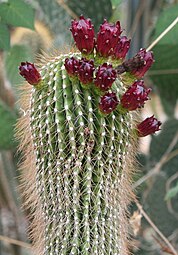| Cephalocereus polylophus | |
|---|---|

| |
| Conservation status | |
 Vulnerable (IUCN 3.1) | |
| Scientific classification | |
| Kingdom: | Plantae |
| Clade: | Tracheophytes |
| Clade: | Angiosperms |
| Clade: | Eudicots |
| Order: | Caryophyllales |
| Family: | Cactaceae |
| Subfamily: | Cactoideae |
| Genus: | Cephalocereus |
| Species: | C. polylophus |
| Binomial name | |
| Cephalocereus polylophus (DC.) Britton & Rose | |
| Synonyms | |
| |
Cephalocereus polylophus is a species of cactus endemic to Mexico. Often grown under the synonym Neobuxbaumia polylopha, it is popular with cactus growers and reproduces well in cultivation.
Description
Cephalocereus polylophus grows individually and reaches heights of up to 13 m (43 ft) or even 15 m (49 ft) and can grow to weigh many tons. The columnar shoots are initially light green and become darker with age. They have diameters of up to 50 cm (1 ft 8 in). The 22 to 36 (rarely from 10) narrow, slightly curved ribs are separated from each other by a sharp furrow. The single, flexible central spine, which can also be missing, is often shorter than the seven to eight marginal spines. The marginal spines are flexible and 1 to 2 cm (0.4 to 0.8 in) long. They are yellowish to brownish and turn gray with age.
The flowers usually appear in groups near the tips of the shoots. They are dark red, 4 to 6 cm (1.6 to 2.4 in) long and reach a diameter of 30 to 35 mm (1.2 to 1.4 in). Its pericarpel and floral tube are covered with fairly large tubercles and small scales that are glabrous in the axillae. The egg-shaped, green fruits are 24 to 40 mm (0.9 to 1.6 in) long and covered with scales, wool and bristles. The fruits are edible by humans and have a delicate, nutty flavor.
Taxonomy
The first description as Cereus polylophus was published in 1828 by Augustin Pyramus de Candolle. The specific epithet polylophus is derived from the Greek words poly for 'many' and lophos for 'crest', referring to the numerous ribs of the species. Nathaniel Lord Britton and Joseph Nelson Rose placed the species in the genus Cephalocereus in 1909. Further nomenclature synonyms are Pilocereus polylophus, Neobuxbaumia polylopha, and Carnegiea polylopha.
Distribution
Cephalocereus polylophus is native to the Mexican states of Hidalgo, Querétaro, Guanajuato and San Luis Potosí.
Conservation
Neobuxbaumia polylopha was assessed as "vulnerable" in the 2009 IUCN Red List, where it is said to be native only to the Mexican states of Hidalgo, Querétaro and Guanajuato. As of April 2023, N. polylopha was regarded as a synonym of Cephalocereus polylophus, which Plants of the World Online gives a somewhat wider distribution.
References
- ^ Succulent Plants Specialist Group (2009-11-17). "Neobuxbaumia polylopha". IUCN Red List of Threatened Species. Retrieved 2023-11-02.
- ^ "Cephalocereus polylophus (DC.) Britton & Rose". Plants of the World Online. Royal Botanic Gardens, Kew. Retrieved 2023-11-05.
- ^ Yetman, David (2007). The Great Cacti. Tucson: University of Arizona Press. p. 6,35,43,137,142–143. ISBN 978-0-8165-2431-0.
- ^ Anderson, Edward F.; Eggli, Urs (2005). Das grosse Kakteen-Lexikon (in German). Stuttgart (Hohenheim): Ulmer. p. 439. ISBN 3-8001-4573-1.
- de Candolle, A.P. (1828). "Cereus". Mémoires du Muséum d'histoire naturelle. Vol. 17. G. Dufour. Retrieved 2023-11-05.
- Liddell & Scott (1940). "λόφος". A Greek–English Lexicon. Oxford: Clarendon Press. Retrieved 2023-11-06.
- "On-line Guide to the positive identification of Members of the Cactus Family". On-line Guide to the positive identification of Members of the Cactus Family. Retrieved 2023-11-05.
External links
 Media related to Cephalocereus polylophus at Wikimedia Commons
Media related to Cephalocereus polylophus at Wikimedia Commons Data related to Cephalocereus polylophus at Wikispecies
Data related to Cephalocereus polylophus at Wikispecies
| Taxon identifiers | |
|---|---|
| Cephalocereus polylophus | |
| Neobuxbaumia polylopha | |
| Cereus polylophus | |


